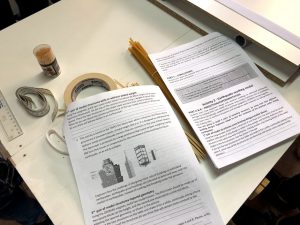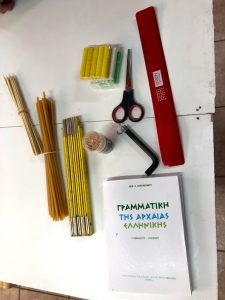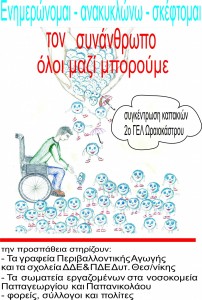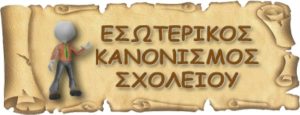
STEM & IBSE in action: earthquakes and engineering in the classroom.
Eftychia Karagianni, Science teacher-Physicist,,& Christos, Alexakis, Mathematician, 2nd General Lyceum of Oreokastro
As concerning the European Erasmus+ Programme, our school, the 2nd General Lyceum of Oreokastro is planning to run a STEM lesson titled “Earthquakes & Engineering in the classroom”. Although we cannot escape earthquakes, as they can happen in any unpredictable time, we can resist them by designing anti-seismic buildings (hospitals, houses, skyscrapers, bridges, roads etc).
Engineers use small or full-scale models to investigate a structure’s response to an earthquake: how safe would the building be in an earthquake and how could it be improved. The STEM lesson that we’ll be carried out in our school is based upon the above idea and it includes 3 activities.
Activity 1 – Earthquake shaking table
Students are invited to construct an earthquake shaking table which simulates the effect of an earthquake on a structure. It’s a platform that mimics the ground motion caused by an earthquake, by producing vibration. Students can monitor the vibrations with the use of a smartphone instead of a real seismograph, by installing and running the application “Vibrometer”.
Activity 2 – Earthquake working model
Students learn how engineers design and construct buildings to withstand earthquake damage by building their own model structures using simple materials such as toothpicks , marshmallows/playdough, spaghetti(thin and thick spaghetti), GEOMAG strong magnets.
They learn how to reinforce structures and strengthen weak materials by testing them on the shaking table.
Activity 3 – The power of a shake
This activity demonstrates the relationship between earthquake power and ground movement, by dropping a heavy object on a piece of wood from different heights, producing different ground-shaking powers. The students should conclude that the more energy is released, the more the ground vibrates.
Learning objectives
After these activities, students should be able :
- Cognitive Domain
– to come in touch with the theme of earthquakes and seismic waves, their nature and why severe damage occurs to buildings as a result of Newton’s law.
– to identify some of the factors that make buildings earthquake-proof, including cross bracing, large “footprints”, and tapered geometry.
– to compare a model structure with what it represents.
– to understand why engineers need to learn about earthquakes and how science can benefit the society.
- Affective Domain
-to listen to others with respect
-to participate in class discussions
-to cooperate in group activities (teamwork)
– to show the ability to solve a problem by using an objective approach.
- Psychomotor Domain
– to make quantitative and qualitative judgments relating to seismic waves and their intensity.
– to model an earthquake-proof structure using simple materials, by following certain instructions in a manufacturing process.
– to perform a mathematical equation (potential energy: U=mgh) as demonstrated.
STEM Worksheet: https://docs.google.com/document/d/18FBhas-Zwazfy88T5TlorbpX0HAnLzHRrozKpRmTbLM/edit?usp=sharing
STEM in Action-Worksheet
EARTHQUAKES & ENGINEERING in the Classroom
GROUP1 –Names 1:…………………………………………………………………………………..
2:……………………………………………………3:………………………………………………………
4:……………………………………………………5:………………………………………………………
6:……………………………………………………7:………………………………………………………
Activity 1 – Earthquake shaking table
Definition:This is a device that can be used to test the response of structural models, to verify their seismic performance by simulating ground motions.
Instructions: Watch the video carefully in order to construct the shaking table, by using the following given materials.
MATERIALS : -2 sheets of cardboard or light wood
-2 PVC pipes
-2 flat elastic materials
- To monitor an earthquake we can use a SMARTPHONE instead of a real seismograph. For this purpose, we install the application “Vibrometer” via Play Store.The vibrometer measures the intensity of the vibration/earthquake.
PART A – PREDICTION
- Shake the table acting upon it different values of force with your hand (weaker to stronger forces). How do you think that the shake table will responde to these different forces?………………………………………………………………………………………………………………………………………………………………………………………………………………………………………………………….
2.If we replace the upper wooden layer with a much lighter sheet of cardboard and repeat the above step, what do you think that will change in the behavior of the shake table?
- the shake table will responde in the same way as above
- the cardboard sheet will move faster than the wooden one.
- the cardboard sheet will move slower than the wooden one.
PART B – EXPERIMENTATION
- Shake the table acting upon it different values of force with your hand (weaker to stronger forces). Take 4 measurements and fill in the following table.
| 1 | 2 | 3 | 4 | |
| Signal amplitude |
Have a discussion with your group mates about the above measurements and justify why that happens………………………………………………………………………………………………………….
…………………………………………………………………………………………………………………………………………
Which famous law of classical Physics takes place? Describe it and write down the relative mathematical formula…………………………………………………………………………………………………………
………………………………………………………………………………………………………………………………………………
- Replace the upper wooden layer with a much lighter sheet of cardboard and repeat the above step. Acting upon it the same force as previously, what difference in the motion of the cardboard layer do you observe? Why does that happen? Discuss it with your group mates.
…………………………………………………………………………………………………………………………………………….
…………………………………………………………………………………………………………………………………………….
PART C – CONCLUSIONS
Discuss your ideas and compare them with those coming out from steps A and B. Please,write down your conclusions…………………………………………………………………………………………….
…………………………………………………………………………………………………………………………………………….
…………………………………………………………………………………………………………………………………………….
……………………………………………………………………………………………………………………………………………..
| The motion of the shaking table is explained by the Newton’s second law of motion (Force=mass∙acceleration, F=m∙a)
· The smaller the mass, the bigger the acceleration. · The bigger the force acting upon a mass, the bigger the acceleration the mass gets, which means stronger vibrations of the shaking table. |
Activity 2 – Earthquake working model
PART A& B – PREDICTION/EXPERIMENTATION
Students learn how engineers design and construct buildings to withstand earthquake damage by building their own model structures using simple materials such as toothpicks, marshmallows/playdough, spaghetti(thin and thick spaghetti), GEOMAG strong magnets.
They learn how to reinforce structures and strengthen weak materials by testing them on the shaking table.
You are going to build 3 pairs of modeling structures, by using each time different building designs Engineers adopt to test the resistance of the structure under strong earthquakes.
1st pair of model structures-cross bracing design/smaller blocks
Using the long wooden sticks make a structure of one block only. The sticks must be joined together with pieces of play dough in order to stay upright, not bending. Build the other structure in the same way with toothpicks, making smaller cross bracing blocks of the same height as the first structure. See the photo in the ppt.
If you put the two structures on the table and shake it for a while, continually acting a force upon it, which one of the structures do you think that will remain more constant to the vibration?………………………………………………………………………………………………………………..
…………………………………………………………………………………………………………………………………………..
2nd pair of model structures-with or without added weight
Using the spaghetti, build two same model towers (of about 20-30cm height and 6-10cm basement dimension). On the top of the second structure hang a weight of about 50gr (given). Place the two structures on the shake table and test their seismic behavior.
What do you see about the seismic performance of the two model structures? Which one do you think will behave better in an earthquake?………………………………………………..
…………………………………………………………………………………………………………………………………………….
…………………………………………………………………………………………………………………………………………….
……………………………………………………………………………………………………………………………………………..
- This activity is based on the TAIPEI 101 Skyscraper which comprises 101 floors above ground and 4 basement levels, of total height 509,2 m. It is designed to withstand the typhoon winds and earthquake tremors that are common in the area of East Taiwan. The skyscraper is protected by a large pendulum/big tuned damper weighing nearby 800 tons that moves to compensate for the movement of the building during an earthquake, so as not to collapse.
Engineers face the challenge of designing more robust buildings to withstand earthquakes. Earthquake-proof buildings are intended to bend and sway with the motion of earthquakes, instead of cracking and breaking under the pressure.
3rd pair of model structures-tapered geometry
Using the GEOMAG magnets, build two model towers. The first tower should be made up of two square blocks on the height, and the second one must end at a cone end block, adopting the tapered geometry, as shown in the picture.
If you put the two structures on the table and shake it for a while, continually acting a force upon it, which one of the structures do you think that will remain more constant to the vibration?………………………………………………………………………………………………………………..
…………………………………………………………………………………………………………………………………………..
……………………………………………………………………………………………………………………………………………
PART C – CONCLUSIONS
Discuss your ideas and compare them with those deriving from steps A and B. Please, write down your conclusions…………………………………………………………………………………………….
…………………………………………………………………………………………………………………………………………….
…………………………………………………………………………………………………………………………………………….
| To improve the seismic behavior of a building to resist the earthquake as a whole, engineers apply several methods, such as: making regular designs, following cross bracing technique, tapered geometry, large “footprints”, added weights on the top of the structure. |
Activity 3 – The power of a shake
This activity demonstrates the relationship between earthquake power and ground movement.
PART A& B – PREDICTION/EXPERIMENTATION
MATERIALS : – object(book)
-scale (measures the mass of an object)
– smartphone (as a vibrometer)
INSTRUCTIONS: First measure the mass of the book on the given scale. Place the vibrometer at the edge of the wooden desk and drop the book from different heights, producing different ground-shaking powers. Make sure that you drop the book onto the same spot each time(same distance from the vibrometer). It is not important exactly what distancefrom the vibrometer you drop the book from. Monitor the vibrometer. The amplitude of the signal depends on the power of the shake
PREDICTION: What do you think will happen? When will the vibrometer show higher signal? a. If we drop the book from a smaller height from the desk, or b from a bigger one?…………………………………………………………………………………………………………………………
……………………………………………………………………………………………………………………………………………
EXPERIMENTATION: Take 5 measurements and fill in the table.
Mass=………………..Kg, gravity acceleration: g=10m/s2
| Height (cm) | 20 | 40 | 60 | 80 | 100 |
| Potential energy U=mgh (J) | |||||
| Signal amplitude |
Have a discussion with your group mates about the above measurements and justify why that happens…………………………………………………………………………………………………
…………………………………………………………………………………………………………………………………………
- Plot a graph of amplitude against height on the given millimeter paper.
- Discuss the graph with your group mates.
PART C – CONCLUSIONS
Discuss your ideas and compare them with those deriving from steps A and B. Please, write down your conclusions…………………………………………………………………………………………….
…………………………………………………………………………………………………………………………………………….
| Before dropping down to the desk , the object(book) has got a potential energy which is proportional to the height (h) of the object from the desk. U=mgh. So the higher the object, the more potential energy it has got, which means the more energy is released when it drops on the ground, and the more the ground vibrates. |















































